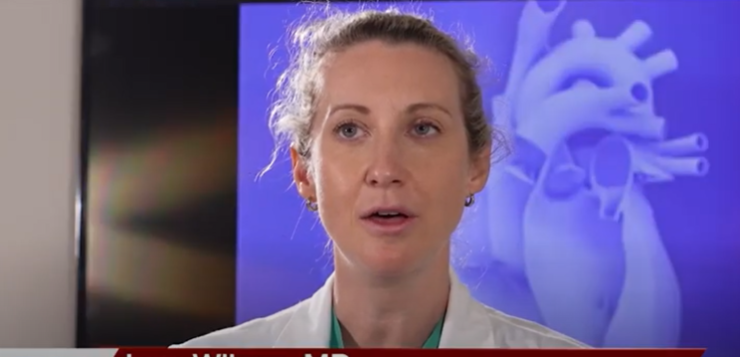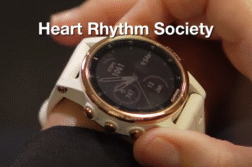Dr. Jane Wilcox, MD, Chief of Heart Failure at Northwestern Medicine’s Bluhm Cardiovascular Institute, talks about how AI is helping improve heart patients’ health.
Interview conducted by Ivanhoe Broadcast News in April 2022.
How many people are suffering from advanced heart failure?
DR WILCOX: So, it’s a little tricky because advanced heart failure can be hard to recognize. But about 1 in 250 individuals, at least in the U.S., are living with heart failure or living with cardiomyopathy, which means heart muscle dysfunction. And of those, we see many people with advanced heart failure. So the absolute number is probably a lot larger than the patients who are referred for therapies for advanced heart failure.
And there’s not a cure. Like, once you have it, it’s just treatment, right?
DR WILCOX: Yes. So once you have advanced heart failure, and the definition of that is that the medications that we use to treat heart failure – these oral medications that have really changed the landscape, have improved outcomes – those medications are no longer working. And so patients have three pathways or three trajectories that they can go on with advanced heart failure. The first is the heart transplant list, but transplants are very limited. We do about 2,200 transplants in the U.S. a year and there are about 75 patients – 75,000 patients who could benefit from transplant. So the next option is left ventricular assist device, which is an open heart surgery. It’s a procedure where we implant a surgically implantable pump into the left ventricle, which is the main pumping chamber, and that takes over the work of the heart. And patients live many years on this advanced pump or durable pump. And then the third trajectory is what we call palliative inotropes, which means medicines that are injected through the arm. And they improve quality of life, not necessarily quantity of life. Said a lot. Probably too much.
So how are you using AI as part of your diagnosis of this?
DR WILCOX: So AI, or augmented intelligence – we have changed it to augmented intelligence as opposed to artificial intelligence because what we’re really doing is trying to help out the clinician. Clinicians are very busy, and like I said earlier, advanced heart failure can be sort of tricky or nuanced to identify. And so we’ve created algorithms using AI, using machine learning to try to find patients, and we found patients successfully. But we find these patients who may benefit from referral early for advanced therapies. And so we use clinical data, we use imaging data, we use what we call unstructured data, and we use natural language processing to put it all together and then apply it system-wide so that patients – we can find patients who may benefit from early referral to advanced therapy, to our advanced therapies clinic.
So is this before someone gets into – like, before their diagnosis in advanced heart failure? Like, you’re catching this before?
DR WILCOX: Yeah. So we – it’s actually really cool. So we are able to broadly apply our algorithms and then sort of stratify patients who – at their risk level who have heart failure. So we are finding patients who have heart muscle dysfunction, but may have not, you know, seen a cardiologist or may not be on all of the appropriate medications. We can then work with their local cardiologist or their local physician to, you know, get them on appropriate medications. And then on the other end of things, we can find patients who may be sliding, may be approaching advanced heart failure. And we can sort of pick off those patients and funnel them into our advanced therapies clinic where they can hear about transplant, LVAD, those palliative inotropes, sort of before it’s too late. And one of the things I love about this program is that it, you know, it’s augmented. It doesn’t – it’s not, you know, big brother watching over you, sort of taking over the care of the doctor, but it’s augmenting care – you know, the patient, the physician, the team. And it’s sort of, you know, augmenting that relationship. And it, you know, it doesn’t let people fall through the cracks. And so it really, I think, is improving equitable access to our advanced heart failure therapies.
And how does it work? Does it – is it taking information from people who have already had advanced heart failure and then seeing, like, there are symptoms there, everything that went into it?
DR WILCOX: So if you’re a patient at Northwestern, you can feel sort of comfortable, confident that we have these algorithms running in the background, that if you are at risk, if you are one of those patients who has heart muscle dysfunction as defined by imaging, clinical criteria that exists in our medical record but it’s you know, it’s a lot to look through. You have to find different tabs, you know, sort of like, you know, it’s sort of nuanced to try to figure out who – which patients might benefit from which therapy. So that – all that information is running in the background. And then we can sort of remind clinicians, we can talk to them about referral, we can approach patients directly that, hey, you know, you might benefit from this clinical trial. You might benefit from this evaluation for advanced heart failure therapies.
And is this augmented intelligence always learning new, adding more?
DR WILCOX: It is. It’s iterative, yes. So we have, you know, we have our beta version that we started. We sort of put it across the system or applied it across the system and found that there were patients out there that, you know, could benefit from earlier referral. And we’ve gotten them into our -what we call new access clinics. We’ve actually – one patient has received an LVAD, and the other patient has received a transplant. So we know that there are patients out there. We want to make the algorithms better and better and sort of catch things upstream, right? If we can catch patients who are less sick, potentially they could be a candidate for a clinical trial. They could, you know, there’s unlimited possibilities. But it seems to be working so far.
And it seems like this is just the future of every…
DR WILCOX: Absolutely. It’s helping the clinician. And in this age of medicine that is highly complex, there’s so many things to learn. I mean, when I was training, I felt like I was – there was a lot to learn. And now I’m attending on rounds and I’m like, oh, my gosh. I don’t, you know, I don’t even know what the residents and fellows – like, what antibiotic they’re talking about. Like, this is so complex. There are so many new therapies. And so, this is a way, I believe, to sort of level the playing field. And we can kind of find patients who maybe, you know, would benefit from a particular pathway – right? – a particular care pathway and use bioinformatics and data analytics to improve their health care.
END OF INTERVIEW
This information is intended for additional research purposes only. It is not to be used as a prescription or advice from Ivanhoe Broadcast News, Inc. or any medical professional interviewed. Ivanhoe Broadcast News, Inc. assumes no responsibility for the depth or accuracy of physician statements. Procedures or medicines apply to different people and medical factors; always consult your physician on medical matters.
If you would like more information, please contact:
Megan McCann
(312) 926-5900
Sign up for a free weekly e-mail on Medical Breakthroughs called First to Know by clicking here




